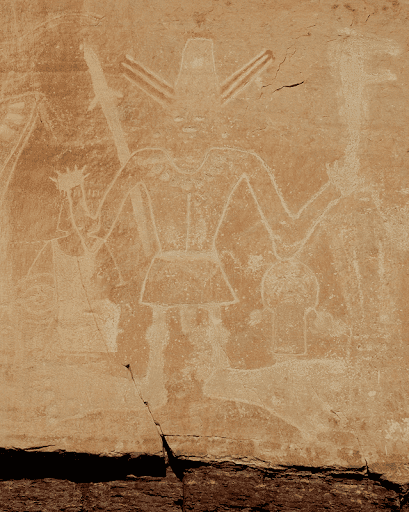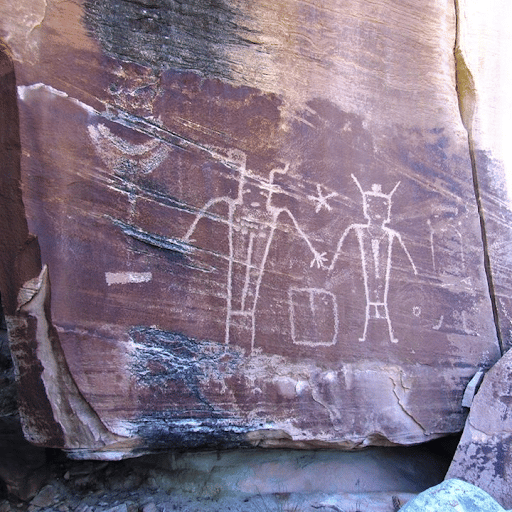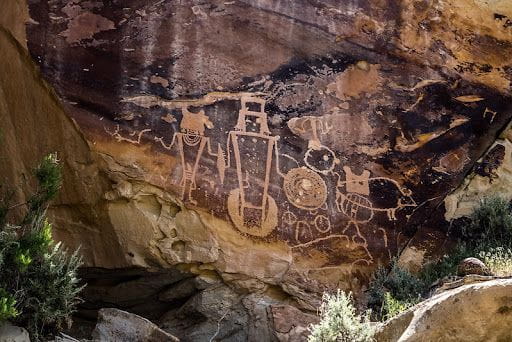Explore Ancient Petroglyphs

Petroglyphs are ancient carvings etched into the top layer of stone. People created them using stone chisels and hammerstones. Archaeologists have estimated there may be over 25,000 petroglyph images in Dinosaur National Monument.

Get a glimpse into Utah’s ancient past and discover the lives of people who lived here thousands of years ago!
Our state has some of the world’s best petroglyphs. And Dry Fork Canyon, one of the world’s most famous sites, is right here in Vernal!
Want to see more? There are plenty of historical sites that you can visit across Utah.

Location: McConkie Ranch, just north of Vernal
The Dry Fork Canyon petroglyphs are famous for their quality and accessibility. These panels cover 200 feet of cliff face and date from 300-1300 A.D. They are excellent examples of the Fremont Native American culture.
The petroglyphs are located on private land. Access is granted to those who treat the artwork with respect.
Address: 6264 N. McConkie Rd, Vernal, UT 84078, United States
Website: www.McConkieRanch.com
Details: Cultural Site. Donations accepted. Seasonal Closure December 1st through March 31st
Getting to McConkie Ranch from Vernal, Utah, is easy:
Dinosaur National Monument, near Vernal Utah, has many petroglyph sites. Here are some you can visit:

Image courtesy of Mark Byzewski
McKee Spring is one of Dinosaur National Monument’s best sites. It is easily accessible from the road, either by hiking or driving. However, the track becomes muddy in wet conditions and may be impassable.
McKee Spring is about 22 miles from the Dinosaur National Monument visitors’ center. The best way to get there is to go there, ask for directions, and find out if the conditions are suitable to go there.
Tilted Rocks is home to many stunning petroglyphs. This includes the Swelter Shelter, a rock panel showing many animals, including snakes, birds, and lizards. The best way to see them is to go to the Quarry Visitor Center north of Jensen and then follow the scenic Cub Creek Road. Viewing some of the petroglyphs may involve a short, steep walk from your car. It’s a good idea to ask for the exact location of the petroglyphs at the visitor center.

Image courtesy of Matthew Dillon
The Echo Park area is home to many petroglyphs. Some are located on a ledge above the campground, others are at Pool Creek, and a few are across the Green River opposite the raft-launch site.
The last 13 miles on the road to Echo Park are unpaved roads. These roads are impassable when wet and steep in some places. A 4×4 is recommended. It’s also a good idea to speak to the folks at the Canyon Visitor Center about weather conditions before heading to Echo Park. You can contact them at (970) 374-3000.

Image courtesy of Bruce Hope
The Jones Hole area is a scenic canyon with some of Dinosaur National Monument’s most impressive petroglyphs.
These petroglyphs can be found near Deluge Shelter, approximately 1.5 miles (2.4 km) from the trailhead at the fish hatchery.
Vernal, Utah, is a great base from which to explore other ancient petroglyph sites across Utah.
Some famous examples include:
Location: Indian Creek Canyon, 53 miles south of Moab, just outside Canyonlands National Park
Newspaper Rock is one of the largest known collections of petroglyphs in the United States. The rock panel is covered by hundreds of designs.
It’s called Newspaper Rock because its images depict past events like a newspaper. It also features carvings of deer, buffalo, pronghorn antelope, and riders on horseback.
Newspaper Rock provided the ideal surface for petroglyphs thanks to its desert varnish. This is a dark coating on the rock created when manganese-iron deposits form on exposed sandstone cliffs over thousands of years.
Indigenous people were able to chip away the desert varnish, revealing the lighter-colored rock underneath. This helped their designs stand out.
Location: Near the junction of Courthouse Wash and the Colorado River, Arches National Park.
The Courthouse Wash doesn’t just have petroglyphs. It also features a series of ancient rock paintings known as pictographs. These images show a range of figures, some measuring up to 5 feet in height.
The painted figures are thought to have been created by the Fremont people and are between 1,500 and 4,000 years old.
To reach the site, follow the trail half a mile from U.S. 191 northeast of Moab. Sadly, the site was once vandalized, but it has since been restored. These sites are to be visited with respect.
Location: Bears Ears National Monument, Southeastern Utah
Bears Ears National Monument features many examples of Anasazi petroglyphs. Some of the most impressive ones can be seen on the Sand Island Petroglyphs Panel.
The rock features over 100 years of designs that are thought to be between 300 to 3,000 years old.
It is thought that the panel held special significance to the people who created it, and it could have been an ancient gathering place.
The main petroglyph panel is located near the Sand Island Campground which has restrooms, camping sites, a seasonal ranger station, a boat launch, and seasonal drinking water.
Sand Island is just off Highway 191. At the bottom of the hill leading up to Sand Island, you will see a sign directing you to the Petroglyph site to the right. Drive 0.2 miles to the parking lot near a chain-link fence. The petroglyphs are only a short walk away up a dirt path.
The ancient petroglyphs in and around Vernal, Utah, raise so many questions! Who created them? How? And why? In this section, we answer these questions and more.
The Indigenous Fremont people created most of Utah’s petroglyphs thousands of years ago. Their culture revolved around farming and they lived in the state between 800 and 1,500 years ago. Many examples of their art, culture, and society still exist today.
However, it wasn’t just the Fremont people who created rock art in Utah. Others include:
Utah’s petroglyphs show a wide range of animals, symbols, and humans.
The inscriptions give us an exciting glimpse into how Utah’s ancient people lived. The petroglyphs show people wearing elaborate face paint, jewelry, and clothing. They also have a variety of different hairstyles.
Some figures are shown holding shields, spears, or bows and arrows—suggesting that these people hunted and even went to war.
Many animals are shown too, including bighorn sheep, grizzly bears, rattlesnakes, buffalo, deer, elk, birds, scorpions, lizards, coyotes, and dogs.
No one knows for sure! Petroglyphs were probably created for a variety of reasons. Some theories include:
Some even think they may have originated when people sharpened tools against the rock!
Pictographs are prehistoric drawings created by painting on the top layer of the rock. They are different to petroglyphs, which are created by removing the top layer of rock.
Pictographs are more delicate and vulnerable to being weathered away. This makes them rarer and they are typically found only in caves or other places protected from the elements.
Together, these ancient art techniques are known as petrographs.
There’s no way to be certain. However, the images themselves give us some clues.
We know some tools, weapons, and even animals were not in the area before a certain date. For example, we know that horses weren’t introduced to North America until Europeans arrived. Images showing horses must therefore be relatively recent in comparison to others.
Petroglyphs showing a bow and arrow, on the other hand, could be up to 2,000 years old.
Petroglyphs and pictographs are very fragile, so it’s important not to do anything that could damage it.
When visiting petroglyphs remember:
Unfortunately, some damage to the petroglyphs happened because of vandalism. It is a federal offense to deface, damage, or remove any part of the petroglyphs.
Petroglyphs allow you to step into Utah’s ancient past. No visit to Dinosaurland is complete without visiting one of these fascinating sites.
To discover them for yourself, book your visit to Vernal, Utah today.